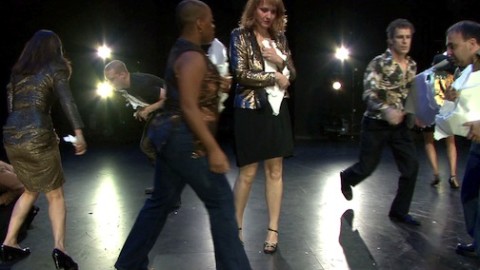Although Alix Pearlstein (b. 1962, New York) received an MFA in sculpture from SUNY Purchase in 1988, by the late 1990s she had focused her practice on video. Ironically, she used the medium to explore the primacy of two-dimensional art. Pearlstein drew her references from painting, advertising, print, and photography for her early works, and she saw the images in the black box of the video monitor as two-dimensional pictures. Nonetheless, rather than being shown as autonomous or as is, the images play roles in her narratives, many of which involve the exploitation or destruction of those figures.
_Two Women_ (2000), for instance, deals with the relationship between desire and mass-media imagery. In the foreground of the frame, Pearlstein holds a cut-out of a nude woman from a magazine like a puppet. Along with sexually charged voice-overs, she uses the image to taunt a man standing in the stark white background. The man paces around while stealing glances at the picture and eventually disrobes to kiss and fondle the cut-out as he would an actual woman.
Like _Two Women_, Pearlstein’s early abstract vignettes often are set in isolated, indeterminate spaces. They also typically feature an ensemble of professional actors who speak scant, incomprehensible dialogue or say nothing at all. In this way, the works rely on viewers’ associations with particular figures and gestures to explore the dynamics of power and control as well as the shifting psychologies they entail. In particular, Pearlstein’s works often examine the dark side of human behavior, as in _Forsaken_ (2003), which depicts the rise and fall of a leader. At first a group of admirers sycophantically cater to him, but eventually his impudence causes a couple of the followers to turn on him. When one destroys a poster of his image, it sets off a chain reaction of aggression and violence that leaves him beaten and lying on the floor of a white cube-like setting.
Pearlstein’s later works are decidedly more stylized than her earlier pieces, but no less introspective, as she employs actors to focus on or stand in for viewers. Set in a rehearsal space, _Talent_ (2009) references the 1975 musical _A Chorus Line_. As a group of actors stand in line for an audition, they vie for attention from Pearlstein and the camera, both of which are visible in the reflection of the mirror behind them. During the course of this loose, non-narrative piece, the performers slip in and out of their acting personas. _Talent_ thereby contemplates the nature of performance—as in behavior and as opposed to acting—and its relation to being in the world.
Pearlstein also views the subject of _The Drawing Lesson_ (2012) as the “affective relationship between, the camera, the viewer, and the subject.” Perhaps her most minimalist work, it was filmed in an all-white cyclorama—giving the illusion of infinite space—with a camera that continuously spins in and around the room and actors. The circling view shows seated actors first looking at each other and then into the camera with increasing intensity. Their rapt gazes indicate a relationship developing between them and the camera, which, upon exhibition, becomes an engagement with the viewer.
In many ways, _Goldrush_ (2008) bridges the early and current phases of Pearlstein’s practice. The action takes place on a soundstage where an ostentatiously dressed man appears to set down a large panel of foam core. Within seconds, seven other similarly attired people (including Pearlstein herself) run onto the stage to tear and grab pieces of the panel for themselves, an act that Pearlstein found to be “truly cathartic.” They claw at and fight each other mercilessly for fragments, a scene that recalls the senseless greed of and resultant ruin from such contexts as the 1840s “Gold Rush” or perhaps the current art market. Nonetheless, the enactment signals a shift from Pearlstein’s focus on the art object (that essentially is torn to shreds) to her interest in performance. Likewise, _Goldrush_ also suggests that the desire for objects—gold nuggets, paintings or other items—ultimately has little to say about those possessions, but rather conveys a great deal about the people who pursue them. _—Kanitra Fletcher_

